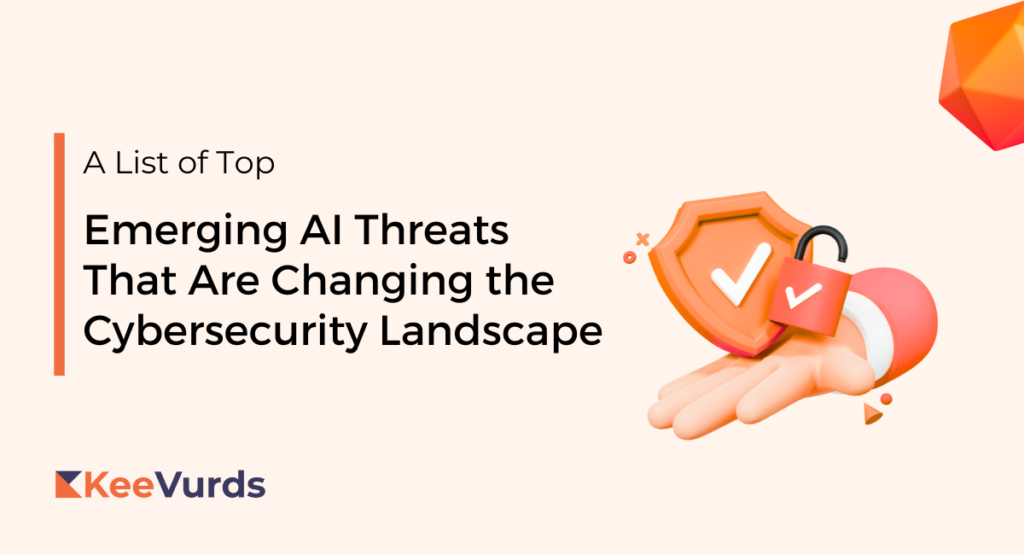When a new technology like AI becomes widely adopted, it brings both opportunities and risks. The same is true in cybersecurity. While AI is helping organizations detect threats faster and automate responses, it is also creating new types of attacks that are harder to spot and stop.
AI-powered phishing, deepfakes, and automated malware are just a few of the emerging threats changing how we think about digital safety.
If you are an organization relying on digital infrastructure, understanding these threats is no longer optional. In this article, let us break down the key AI-driven risks and how they are reshaping the cybersecurity landscape today.
5 Major AI Threats In The Market
Below are some of the major AI threats currently affecting businesses and cybersecurity teams. These threats are already active in the market and continue to evolve with new use cases and attack methods. Understanding them is important for staying one step ahead.
1. AI-Powered Phishing Attacks
AI is making phishing attacks more convincing and harder to detect. Threat actors now use AI tools to mimic writing styles, generate fake voices, and personalize messages at scale. This means traditional filters and human judgment are no longer enough.
These AI-generated emails or messages often bypass standard security protocols and trick employees into revealing sensitive data. Organizations in the UAE can check out the Cybersecurity Report 2025 by CPX, one of the top cybersecurity companies in the region. The report offers a detailed look into phishing, ransomware, and APTs, with a clear roadmap to strengthen defenses.
2. Deepfake-Based Social Engineering
Deepfakes are no longer just a novelty. Attackers are using AI-generated videos and voice recordings to impersonate executives, trick employees, and gain unauthorized access to systems. A deepfake message in a CEO’s voice asking for urgent transfers or sharing login credentials can cause serious damage.
These attacks are especially dangerous in industries where verbal approvals still hold weight. Businesses need to implement strong verification steps beyond voice or video confirmation and train employees to question even realistic media if it comes through unusual channels.
3. Automated Malware Generation
AI can now generate new malware variants faster than ever. These programs can mutate code on the fly to bypass antivirus software and endpoint detection systems. What once took weeks of manual coding can now be done in minutes using AI models.
This has raised the threat level for all types of organizations, especially those with outdated or reactive defenses. Automated malware is also being used in targeted attacks, learning from each failed attempt to improve the next. Constant monitoring and AI-based defense systems are key to keeping up with this level of automation.
4. AI-Driven Vulnerability Exploits
Cyber attackers are using AI to scan codebases, applications, and systems to find zero-day vulnerabilities faster than manual teams. Once a weak point is found, AI tools can simulate various attack paths and identify the most effective one in real time. This has increased the speed and success rate of breach attempts.
Traditional patching and testing cycles often cannot keep up. Organizations should invest in AI-based security tools that proactively scan and simulate threats within their own systems before attackers do the same from the outside.
5. Data Poisoning in Machine Learning Models
As more organizations use machine learning, attackers are finding ways to poison the data used to train these models. By injecting subtle but harmful data into training sets, they can cause the model to behave incorrectly in real-world use.
This is especially dangerous in areas like fraud detection, cybersecurity, and automated decision-making. A poisoned model may start allowing unauthorized access or ignoring real threats. Regular audits, strict data control, and training with verified sources are essential to protect the integrity of AI systems.
How to Evolve Your Cybersecurity Strategy for the AI Era
Traditional cybersecurity tools and practices were built to counter known threats using rule-based detection, firewalls, and human-led monitoring. But with AI now powering both defenses and attacks, the approach must shift. Cybercriminals are using AI to create smarter, faster, and more adaptive threats that can’t be stopped by static security measures.
To stay secure, organizations need to evolve from reactive security to proactive, AI-augmented strategies that detect patterns, anticipate behavior, and respond in real time.
Below is a comparison to show how your cybersecurity model should shift for the AI era:
| Traditional Approach | AI-Era Approach |
|---|---|
| Signature-based threat detection | Behavior-based and predictive threat models |
| Manual review and incident response | Automated response using AI and machine learning |
| Static firewalls and rule sets | Adaptive, context-aware defense mechanisms |
| Periodic vulnerability scans | Continuous real-time threat monitoring |
| Focus on network perimeter security | Zero-trust architecture and endpoint-level protection |
| Reactive training after incidents | Continuous employee awareness using AI simulations |
| One-size-fits-all threat models | Dynamic risk profiling and personalized threat response |
These were some important insights from our team at KeeVurds on how AI is reshaping the cybersecurity landscape and what you can do to stay protected.
If you have any thoughts, experiences, or questions to add, feel free to share them in the comments below. You can also explore more of our expert blogs or reach out to us directly if you’re looking to collaborate or need help with cybersecurity content and research.




